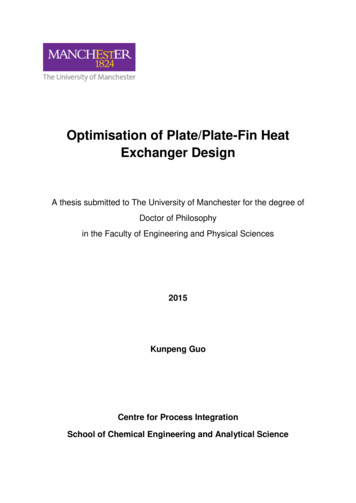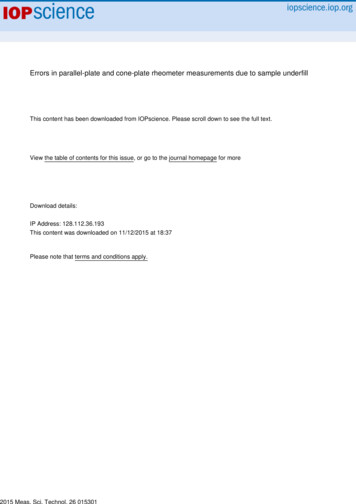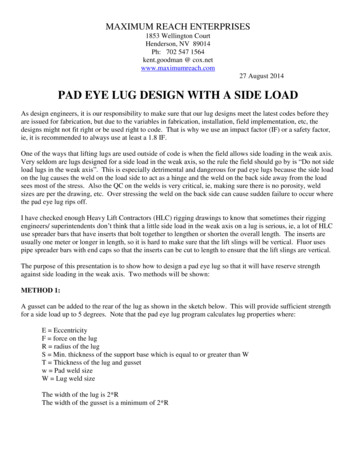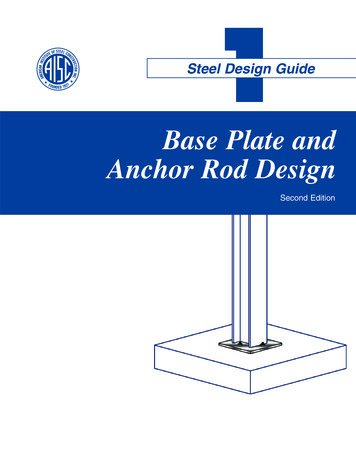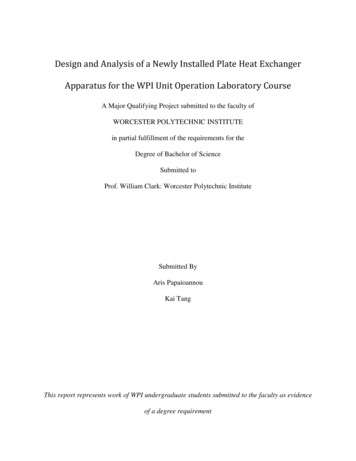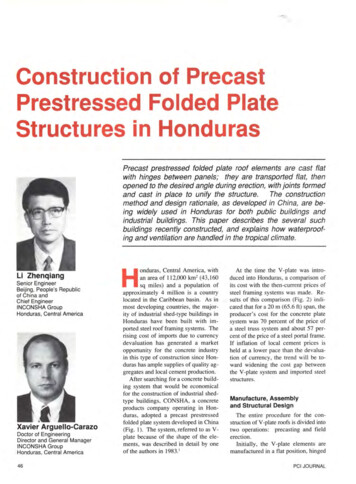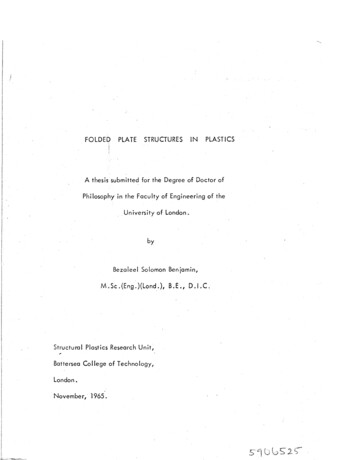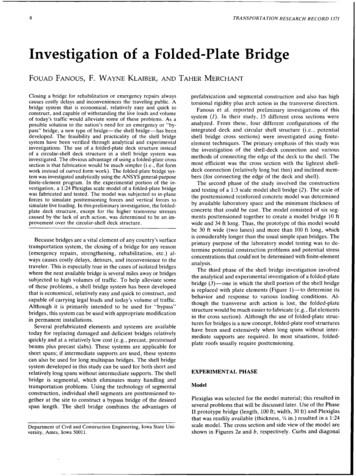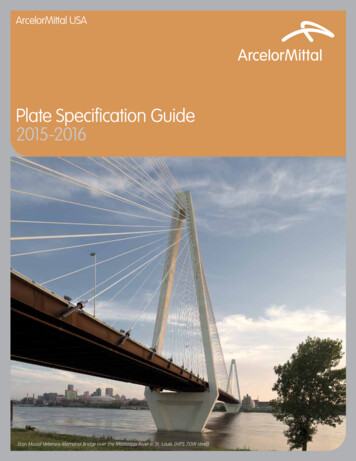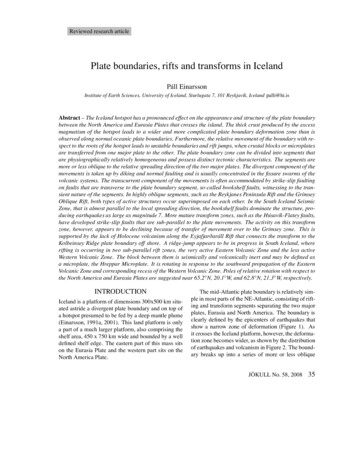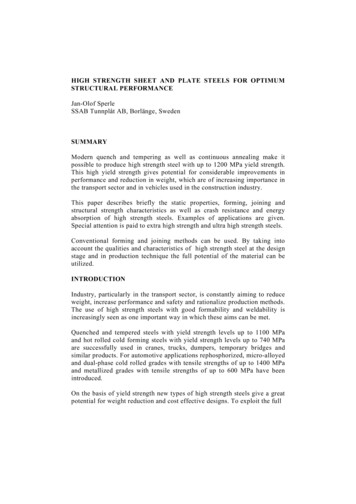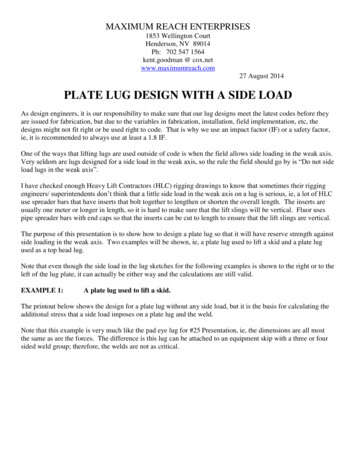
Transcription
MAXIMUM REACH ENTERPRISES1853 Wellington CourtHenderson, NV 89014Ph: 702 547 1564kent.goodman @ cox.netwww.maximumreach.com27 August 2014PLATE LUG DESIGN WITH A SIDE LOADAs design engineers, it is our responsibility to make sure that our lug designs meet the latest codes before theyare issued for fabrication, but due to the variables in fabrication, installation, field implementation, etc, thedesigns might not fit right or be used right to code. That is why we use an impact factor (IF) or a safety factor,ie, it is recommended to always use at least a 1.8 IF.One of the ways that lifting lugs are used outside of code is when the field allows side loading in the weak axis.Very seldom are lugs designed for a side load in the weak axis, so the rule the field should go by is “Do not sideload lugs in the weak axis”.I have checked enough Heavy Lift Contractors (HLC) rigging drawings to know that sometimes their riggingengineers/ superintendents don’t think that a little side load in the weak axis on a lug is serious, ie, a lot of HLCuse spreader bars that have inserts that bolt together to lengthen or shorten the overall length. The inserts areusually one meter or longer in length, so it is hard to make sure that the lift slings will be vertical. Fluor usespipe spreader bars with end caps so that the inserts can be cut to length to ensure that the lift slings are vertical.The purpose of this presentation is to show how to design a plate lug so that it will have reserve strength againstside loading in the weak axis. Two examples will be shown, ie, a plate lug used to lift a skid and a plate lugused as a top head lug.Note that even though the side load in the lug sketches for the following examples is shown to the right or to theleft of the lug plate, it can actually be either way and the calculations are still valid.EXAMPLE 1:A plate lug used to lift a skid.The printout below shows the design for a plate lug without any side load, but it is the basis for calculating theadditional stress that a side load imposes on a plate lug and the weld.Note that this example is very much like the pad eye lug for #25 Presentation, ie, the dimensions are all mostthe same as are the forces. The difference is this lug can be attached to an equipment skip with a three or foursided weld group; therefore, the welds are not as critical.
The drawing below shows the details of the plate lug that agrees with the printout above and also shows the sideload information, ie, 40 kips at a 10 side load angle. Note that bending will be just above the top of theequipment skid, ie, 3.5” down from the centerline of the lug hole.NOW CALCULATE THE ADDITIONAL STRESS IMPOSED ON THE LUG PLATE DUE TO THESIDE LOAD:Refer to the printout and drawing above.Where:The force on the lug P at 10 deg. angleThe horizontal component of the side load force PhThe force on the lug in the strong axisThe angle of the force in the strong axis of the lugAngle of the force in the weak axisThe eccentricityThe allowable yield stress Fb in bending of the A36 plate 36 ksi*.6The allowable yield stress Ft in tension of the A36 plateThe section modulus Sx for bending in the strong axis is2” (thickness of the lug) * 7” (width of the lug) 2/6The section modulus Sz for bending in the weak axis is7” * 2 2/6Bending moment Mz in the weak axis is3.5” eccentricity *6.95 kips Ph * 1.8 (Impact factor IF)Bending stress fbz in the weak axis is43.79 k-in/4.67 cu.in.The ratio of the the bending stress fbz to the allowable bending stress is9.38/21.6 40.00 kips 6.95 kips 39.39 kips 60 deg. 10 deg. 3.5 inches 21.6 ksi 21.6 ksi 16.33 cu. in. 4.67 cu. in. 43.79 k-in. 9.38 ksi 0.43
From the printout above note that the combined stress forthe lug plate without any side loadTo get the total combined stress on the lug plate in the strongaxis and the weak axis, add 0.56 0.43 0.99 1.0 0.56 Good (therefore) the lug plate is good for the 10 side loadNOW CALCULATE THE ADDITIONAL WELD REQUIRED FOR THE PLATE LUG AT THE TOPOF THE EQUIPMENT SKID DUE TO THE SIDE LOAD:Calculate the vertical force F that the weld on the back side of the lug willsee due to the side load.F 43.79 k-in bending moment / 1” ( ½ width of lug) 43.79 kNow, the additional weld required due to the side load is43.79 k/(14.85 k/in*7”width of lug) 0.42From the printout above, the weld requirement for a three sided weld 0.86From the printout above, the weld requirement for a four sided weld 0.54 if the plate lug is to be welded on using a three sided weld, then allwelds should be increased to 0.86 0.42 1.28 in.If the plate lug is to be welded on using a four sided weld, then only the tophorizontal weld should be increased to 0.54 0.42 0.96 in.Recommend using a 1 1/4” & 1.0 in respectivelyEXAMPLE 2:A plate lug used as a top head lug.NOTE:1.This lug design was taken from #6 Presentation2.Two cases will be considered to determine worst case:a.with the vessel in the set position (in the vertical) where the load to each lugb.with the vessel at the initial pick position (in the horizontal) where the load 87.90 kips 52.74 kipsCASE A:The first printout is for the vessel in the vertical at set where the load to each lugAnd the combined stress of the lug plate is 0.24 without any side load. This is forvertical tension only. 87.90 kips
The drawing below shows the details of the plate lug (In this application, it is called a top head lug) that agreeswith the printout above and also shows the side load information, ie, 88.02 kips at a 3 side load angle. Notethat bending will be just above the kicker plate, ie, 6” down from the centerline of the lug hole.
FIRST CALCULATE THE COMBINED STRESS AT THE KICKER PLATE DUE TO THEVERTICAL LOAD ONLY:The tension stress at the kicker plate is87.90 kips vertical load * 1.8 IF/1.5” lug thickness * 13.75” lug width at the kicker plate 7.67 ksiThe combined stress is the ratio of the actual tension stress/allowable tension stress and is7.67 ksi / 21.60 ksi 0.36Note that this is up from the combined stress of 0.24 calculated at the tangent lineNOW CALCULATE THE ADDITIONAL STRESS IMPOSED ON THE LUG PLATE DUE TO THESIDE LOAD:Refer to the printout and drawing above.Where:The force F on the lug in the weak axis 88.02 kipsThe horizontal component of the side load force Fh 4.61 kipsThe angle of the force in the strong axis of the lug 90 deg.Angle of the force in the weak axis 3 deg.The width of the kicker plate 13.75”The allowable yield stress Fb in bending of the A36 plate 36 ksi*0.6 21.6 ksiThe section modulus Sz for bending in the weak axis at the kicker plate is13.75” * 1.5” 2/6 5.16 cu. in.Bending moment in the weak axis is6” eccentricity *4.61 kips Fh * 1.8 (Impact factor IF) 49.79 k-inBending stress fbz in the weak axis is49.79 k-in/5.16 cu. in. 9.66 ksiThe ratio of the bending stress fbz to the allowable bending stress is9.66 / 21.60 0.45From the calculation above for the combined tension stress forthe lug plate at the kicker plate without any side load 0.36To get the total combined stress on the lug plate in the strongaxis and the weak axis, add 0.36 0.45 0.81 1.0 Good the lug plate in the set position is good for the 3 side load shownNOW CHECK THE WELD AT THE KICKER PLATE TO SEE IF IT HAS SUFFICIENT CAPACITYDUE TO THE SIDE LOAD:In this case, the weld between the lug plate and the shell is not affected by the side load, so only the weld at thekicker plate needs to be checked. Note that the 1” kicker plate is welded to the shell and to the lug plate with afull pent. weld. Therefore, it is equivalent to a 1” weld size.The capacity of the 1” weld is14.85 kips/in * 13.75 “ of weld length 204.19 kips204.19 kips 4.61 kips side load Good The lug plate and weld at the kicker plate are good for the 3 side load with the vessel in the vertical.
CASE B:The next printout is for the vessel in the IPP (the horizontal position) where the verticalload to each lugAnd the combined stress of the lug plate is 0.79 without any side load. This is for theIPP load only. 52.74 kips
NOW CALCULATE THE ADDITIONAL STRESS IMPOSED ON THE LUG PLATE DUE TO THESIDE LOAD:Refer to the printout above. A drawing was not made for this case but theInformation is summarized below:Where:The force F on the lug in the weak axis 52.81 kipsThe horizontal component of the side load force Fh 2.76 kipsThe angle of the force in the strong axis of the lug 0.0 deg.Angle of the force in the weak axis 3 deg.The width of the kicker plate 13.75”The allowable yield stress Fb in bending of the A36 plate 36 ksi*0.6 21.6 ksiThe section modulus Sz for bending in the weak axis at the kicker plate is13.75” * 1.5” 2/6 5.16 cu. in.Bending moment in the weak axis is6” eccentricity *2.76 kips Fh * 1.8 (Impact factor IF) 29.81 k-inBending stress fbz in the weak axis is29.81 k-in/5.16 cu. in. 5.78 ksiThe ratio of the bending stress fbz to the allowable bending stress is5.78 / 21.60 0.27From the printout above for the combined tension stress forthe lug plate without any side load 0.79To get the total combined stress on the lug plate in the strongaxis and the weak axis, add 0.79 0.27 1.06 1.0 Good the lug plate in the IPP is good for the 3 side load shownNOW CHECK THE WELD AT THE KICKER PLATE TO SEE IF IT HAS SUFFICIENT CAPACITYDUE TO THE SIDE LOAD:As with the vessel in the set position, the weld between the lug plate and the shell is not affected by the sideload, so only the weld at the kicker plate needs to be checked. Note that the 1” kicker plate is welded to theshell and to the lug plate with a full pent. weld. Therefore, it is equivalent to a 1” weld size.The capacity of the 1” weld is14.85 kips/in * 13.75 “ of weld length 204.19 kips204.19 kips 4.61 kips side load Good The lug plate and weld at the kicker plate are good for the 3 side load with the vessel in the IPP.COMMENTS:1.Note that the side load was taken at the center of the lug hole. If the shackle pin is a tight fit in the lughole, then the side lug force will occur at the bail of the shackle (probably more to the side of the bail)instead of at the center of the lug hole and the eccentricity or moment arm should be taken from thekicker plate up to bearing on the shackle bail or there about, ie, for a 55 Te shackle the eccentricitywould then be /- 11.90” 6” /- 17.90”. In this example, the additional eccentricity would overstress the lug plate. The proof of this is left up to the reader.2.This is why it is strongly recommended that plate lugs not be side loaded, because if they are it isusually hard to determine the correct moment arm to use to be conservative.END OF PLATE LUG CALCULATION FOR A SIDE LOAD
if the plate lug is to be welded on using a three sided weld, then all welds should be increased to 0.86 0.42 1.28 in. If the plate lug is to be welded on using a four sided weld, then only the top horizontal weld should be increased to 0.54 0.42 0.96 in. Recommend using a 1 1/4” & 1.0 in respectivelyFile Size: 1MBPage Count: 11
